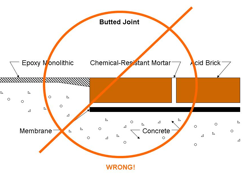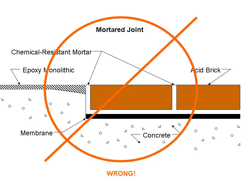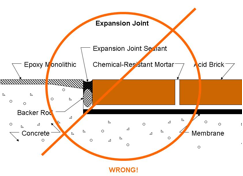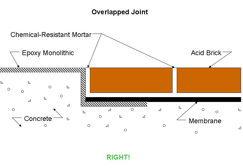Acid Brick-to-Epoxy Flooring Transition Detail
Acid Brick-to-Epoxy Flooring Transition Detail
 Industrial facilities that handle corrosive chemicals often rely on a variety of protective flooring systems. While epoxy toppings might provide sufficient protection for many areas, acid brick flooring might be the best choice for areas subject to thermal shock or mechanical abuse. To avoid maintenance problems where the two types of flooring meet, engineers must carefully design the transition details.
Industrial facilities that handle corrosive chemicals often rely on a variety of protective flooring systems. While epoxy toppings might provide sufficient protection for many areas, acid brick flooring might be the best choice for areas subject to thermal shock or mechanical abuse. To avoid maintenance problems where the two types of flooring meet, engineers must carefully design the transition details.
Let’s consider several possible approaches—a butt joint, a mortared joint, a sealed joint, and an overlap joint.
Butt Joint
 Detail summary: epoxy lining butts into the side of the brick lining, such that the surfaces of both linings are flush.
Detail summary: epoxy lining butts into the side of the brick lining, such that the surfaces of both linings are flush.
The problem with this design is that it introduces a discontinuity in the chemical barrier at the interface between the brick lining and epoxy. US-produced, red shale acid bricks are absorbent. In an acid brick lining, the membrane is the chemical barrier. The bricks could transmit corrosive fluids to the substrate under the epoxy through direct contact.
Mortared Joint
 Detail summary: epoxy lining butts into a mortared head joint, such that the surfaces of both linings are flush.
Detail summary: epoxy lining butts into a mortared head joint, such that the surfaces of both linings are flush.
Mortars that use an acid catalyst—furans, phenolics, and potassium silicates—do not reliably adhere to Portland cement concrete. Theoretically, the acid catalyst reacts with the alkaline concrete at the interface, and the neutralization products interfere with adhesion. In effect, there would be a crevice on the epoxy side of the mortar head joint through which fluids could penetrate and attack the substrate under the epoxy topping.
Sealed Joint
Detail summary: epoxy and acid brick linings do not touch, and the gap is filled with backer rod and sealant.

This detail has the same limitation as the butt joint detail—corrosive fluid can pass from the brick to the substrate under the epoxy. Further, it unnecessarily introduces a weak link into the lining system—joint sealant. Joint sealant typically offers less chemical resistance and durability than epoxy monolithics or acid brick lining systems.
Overlapped Joint
 Detail summary: brick membrane overlaps epoxy monolithic at interface, and head joint at interface is mortared.
Detail summary: brick membrane overlaps epoxy monolithic at interface, and head joint at interface is mortared.
This detail provides good continuity of the corrosion barrier as it transitions from epoxy monolithic to membrane. Filling the head joint adjacent to the epoxy topping with mortar avoids leaving any gaps between the imperfect surfaces of the bricks and epoxy.
There are several different details an engineer might consider when designing transitions between epoxy monolithic and acid brick flooring systems. In order to select the best option, the engineer needs to understand the properties and capabilities of the system components.
- US-produced, red shale acid bricks are absorbent and permeable.
- In an acid brick lining, the membrane is the chemical barrier.
- Certain types of chemical-resistant mortar react with Portland cement concrete before they reach full cure, preventing good adhesion between the mortar and concrete.
- Joint sealant is a weak link in any corrosion protection flooring system in terms of chemical resistance and durability.
With an understanding of these characteristics, an engineer can more effectively design transition details between acid brick linings and monolithic floor toppings.
